Museums and Exhibitions in New York City and Vicinity
| Home | | Museum Guide | | International | | Architecture & Design | | Theater |
GLENN LONEY'S MUSEUM NOTES
CONTENTS, May 2003
[01] Guggenheim CREMASTER
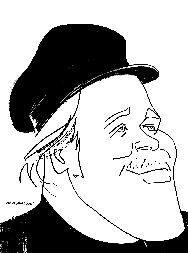
Caricature of Glenn Loney
by Sam Norkin.
[02] Neue Galerie SCHAD
[03] Morgan Flora & Fauna
[04] Painter to Marie-Antoinette at Frick
[05] Bard's Japanese Folk Ceramics
[06] Met's Chinese Export Porcelain
[07] LEONARDO at the Met
[08] Met's MANET/VELAZQUEZ
[09] African-Americans at the Met
[10] STRUTH Streetscapes at Met
[11] Early Humanoids from Spain
[12] Vietnam Journeys at American Museum
[13] MATISSE PICASSO in QNS
[14] Art aus Auschwitz in Brooklyn
[15] Entertaining America at Jewish Museum
[16] FREEDOM: A History of US
[17] 70UP: Female PhotoPortraits
[18] New New York Twenties Women
[19] SCANNING: Robots at the Whitney
[20] Dahesh Moves To Madison
[21] Diane Arbus Set for SF MoMA
[22] Weegee & Fox Talbot at ICP
[23] Outsider Art at Puck
[24] Works on Paper at Armory
You can use your browser's "find" function to skip to articles on any of these topics instead of scrolling down. Click the "FIND" button or drop down the "EDIT" menu and choose "FIND."
How to contact Glenn Loney: Please email invitations and personal correspondences to Mr. Loney via Editor, New York Theatre Wire. Do not send faxes regarding such matters to The Everett Collection, which is only responsible for making Loney's INFOTOGRAPHY photo-images available for commercial and editorial uses.
How to purchase rights to photos by Glenn Loney: For editorial and commercial uses of the Glenn Loney INFOTOGRAPHY/ArtsArchive of international photo-images, contact THE EVERETT COLLECTION, 104 West 27th Street, NYC 10010. Phone: 212-255-8610/FAX: 212-255-8612.
SEARCH THE NEW YORK THEATRE WIRE
The Wright/Right Stuff at the Guggenheim!
Matthew Barney & His Vaseline All Over the Rotunda-
THE CREMASTER CYCLE
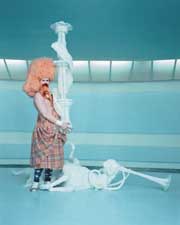 |
| Five Points of Fellowship, 2002 |
Previously, museum-goers have been treated largely to snippets of Matthew Barney's arcane and self-indulgent filmic evocations of Masonic Rituals in service of Higher Art.
Whatever happened to Happenings? Barney has orchestrated and adorned this 1960s concept into something absolutely mind-boggling. Complete with solidified Vaseline curving down the rotunda helix.
The spiraling ramps of the Frank Lloyd Wright Rotunda are littered with piles of white plastic constructions, like so much cordwood. These are props from one of the five Cremaster films this Hugo Boss prize-winner has devised, executed, and even appeared in. There are also salt-casts for those with saline inclinations.
The cliché "words cannot describe" would be a cop-out. Words can indeed describe all the fantastic, even futuristic, satirical visions in Barney's films and supporting artworks and props.
But-after a month photographing Nature and Architecture in Australia-I am so far behind in reporting on new museum shows and productions On and Off-Broadway, that I propose this month only simple listings for both NYMUSEUMS.COM and NYTHEATRE-WIRE.COM.
Otherwise, I will never get caught up, as I have volumes and volumes of new photo-images to prepare for transfer of the entire LONEY INFOTOGRAPHY COLLECTION to the Photo Collection of the New York Public Library on 42nd Street.
In New York Magazine, art critic Hilton Kramer declined to comment on this show, or, as he phrased it: "Matthew Barney's crotch." Although the Cremaster of Barney's film-cycle is a muscle in the crotch, relating to the testicles, his Guggenheim show is much more than the ardent artistic massaging of an itchy scrotum. And far more rewarding…
Jugendstil Vienna Lives Again at Die Neue Galerie-
CHRISTIAN SCHAD and the Neue Sachlichkeit
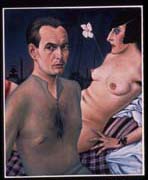 |
| CHRISTIAN SCHAD: Self-portrait with nude-on view at Neue Galerie. |
Nonetheless-after he fled to Zurich, to avoid military service in World War I-Schad's first efforts are related to Dada and Cubism. His amazing picture of Christ Taken Down From the Cross looks like a hundred sparkling facets of that sad scene, gleaming like diamonds or crystal.
His tiny Schadographs-found-objects laid on unexposed photographic-paper-also have a dada-cubist quality. But, when he found his proper style and subjects, he created some very impressive images.
Visitors to the great Beaux Arts mansion at 86th & Fifth Avenue can also enjoy some notable paintings by Gustav Klimt and Egon Schiele. As well as handsome modern artifacts from the Wiener Werkstätte. Some are almost a hundred years old, but they are still modern!
Don't miss the ground-floor Vienna Coffee-House, Cafe Sabarsky! Linzer Torte und Apfelstrudel mit Schlagobers…
Last Chance for the Last Dance at the Morgan Library!
PICTURING NATURAL HISTORY:
Flora & Fauna in Drawings,
Manuscripts, & Printed Books-
 |
| ZODIACAL HORSE at the Morgan Library. |
In fact, work has already begun on the grounds. And all the rooms and galleries but the large entrance gallery have been closed off.
But the impressive variety of centuries of illustrations of plants and animals on view in the big gallery is still worth the visit. Almost a hundred images are on display, some of them from the Morgan's magnificent collection of missals and books of hours.
Maria Sibylla Merian's Surinam Lizard is a striking centerpiece. But a John James Audobon American Brown Pelican also has its own large case
Especially interesting is a 14th century Italian horse-image, showing Signs of the Zodiac relating to parts of the steed's body. And there's an orchid cactus drawing by Beatrix Potter, Peter Rabbit's biographer.
During the Morgan's closure, exhibits from its vast collections will be shown at the Metropolitan Museum-of which J. P. Morgan was also a great benefactor.
Aura of Ancien Régime at the Frick:
Anne Vallayer-Coster:
Painter to the Court of Marie-Antoinette
 |
| ANNE VALLAYER-COSTER: Painter to the Court of Marie-Antoinette, at the Frick. |
And her most admired achievements were in the area of genre-paintings, especially still-lifes. Not vast religious/historical canvases. That was a male domain.
Even the ill-starred Queen of France was a collector of Vallayer-Coster's delicate and decorative works.
What especially distinguished her sketches and canvases of flowers, fruits, and game-animals was her remarkable ability to suggest-with deft brush-strokes and subtle color-the feel or even the sheen of the surfaces of such objects.
The small-scale Frick show-the two basement galleries are intimate indeed-offers some stunning works by this hitherto little-known woman-artist.
At the Bard Center on West 86th:
QUIET BEAUTY:
Fifty Centuries of Japanese Folk Ceramics
From the Montgomery Collection
[27 March-15 June 2003] Until the incursion of the West in
mid-19th century, Japan had no distinction between fine and decorative arts.
This division was an idea imported by American and European experts.
So there was already a ceramics tradition-spanning some 5,000 years-in which even the most humble of household objects could be handsomely decorated.
Selected from Jeffrey Montgomery's definitive collection-preserved in Switzerland, not in Japan-a hundred objects are on display at the Bard Center until June.
Among them are a powerful Horse-eye Plate from the Edo Period. As well as a Shodai Ware Jar, a Karatsu Ware Sake Bottle, and a Yatsushiro Ware Platter.
The pots, jars, beakers, and plates span the Millenia: from 3,000 BC to 1985! The Bard galleries may be intimate, but its curators always manage to display as many objects and texts as possible, consistent with smart exhibition design.
More Asian Ceramics!
At the Met Museum: Chinese Export Porcelain:
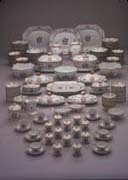 |
| CHINESE EXPORT PORCELAIN: Full Dinner-Service at the Met. |
When Portuguese mariners pioneered a sea-route to the Orient-around the Horn of Africa-they began to import spices, and later tea. Precious textiles and silver followed, with blue-patterned porcelains beginning to find markets in Western Europe.
In the current show, some of the most interesting objects are bowls and dinner-services made for prosperous Dutch merchants, complete with their coats of arms. Initially, painted scenes would be traditional Chinese, but soon the Asian decorators were using European images as well.
When American ships began regular trade with China, great shipments of porcelain and pottery were often regarded as a form of ballast, with tea, textiles, and spices more highly prized. So also in this show there are some examples of patterns created especially for the American trade.
Drawn from the Met's own collections-some 80 artifacts-the objects on display range from the mid-16th century to the Gilded Age in America.
LEONARDO AT THE MET!
[22 January-30 March 2003] You have to pay $20 at MoMA QNS to see Matisse Picasso. But if you pay even more at the Met-$50, in fact-you can study the extensive Leonardo da Vinci exhibition in relative peace. But only on Mondays, when the Museum is closed to the public. If you are a serious student of Renaissance Italian Art you may consider
the money well invested. The detail of many of Leonardo's sketches and diagrams
needs to be seen up close-and not in a hurry. On most days at the Met, you
can hardly get near the showcases. So Mondays are a Must.
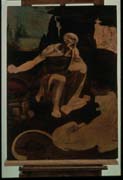 |
| LEONARDO's Unfinished "St. Jerome" at the Met. |
Do not expect to see the Mona Lisa or the National Gallery's magnificent Leonardo Ginevra. This show is not about Da Vinci as painter. Instead, it's titled: Leonardo da Vinci Master Draftsman.
The only quasi-painting included is Leonardo's unfinished St. Jerome Praying in the Wilderness. And this is presented as essentially a sketch for the painting that should have been.
Longtime museum-goers have surely seen some of the drawings in this show in other Leonardo blockbusters. One memorable show offered Leonardo drawings and models actually constructed from his sketches for various practical and visionary purposes.
In fact, the Codex Leicester-now owned by Microsoft's Bill Gates-was previously widely shown as the Codex Hammer. When Armand Hammer bought something rare and priceless, he loved to put his name on it! Gates is more modest-and a great deal richer.
Leonardo's reluctance-or outright failure-to complete certain important painting commissions is noted in this show.
But his wide-ranging concern with all kinds of scientific and practical problems-as evidenced in his mirror-written notes and myriad sketches-suggests that his fertile brain was constantly teeming with questions that needed examination and, if possible, solutions. The paintings could wait.
Nor was Leonardo always able to function as a free-agent. His services to Duke Sforza in Milan were perhaps most important in the areas of fortification, defense, weaponry, and hydraulics.
The Met's range of drawings is by no means focused on Leonardo's scientific speculations. Sketched portraits and studies for paintings are on view. Notable are the grotesques Leonardo captured on paper: people with odd noses and other deformities.
A Latinate Congress of Masterpieces!
Manet/Velázquez:
The French Taste for Spanish Painting-
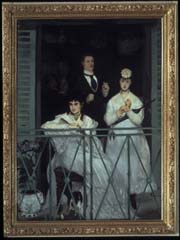 |
| THE BALCONY: Manet masterpiece from the Met's "Manet/Velázquez." |
Seldom have so many important and impressive paintings been crowded into the Met's special exhibition galleries. If some canvases seem almost as closely hung as in a Victorian museum, it's often to reinforce the relationships between Spanish subjects and compositions and French works obviously-or more subtly-influenced by them.
Although the paintings of Diego Rodríguez de Silva y Velázquez were a seminal influence on Manet, there are not that many of them in this show. But the choices are of major importance.
For the purposes of the exhibition, Velázquez is almost more of a symbol of the vitality of Spanish painting of the 17th century. There are far more images of Francisco de Goya y Lucientes on show.
Also strongly featured are works by Murillo, Zurbaran, and El Greco, as well as other Spanish masters of that period. What's most interesting is the fact that it took almost 200 years for these powerful Spaniards to excite the artistic sensibilities of French painters!
Manet is heavily represented on the Met's walls, but other French painters also fell under the Iberian Spell: Degas, Millet, Courbet, and Delacroix.
American painters who studied in Paris were also influenced. Included at the Met are John Singer Sargent, William Merritt Chase, Thomas Eakins, James Abbott McNeill Whistler, and Mary Cassatt.
EQUAL TIME FOR ETHNIC ARTISTS!
The Met's African-American Artists: 1929-1945-
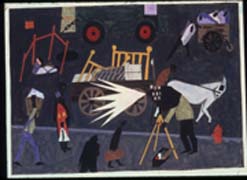 |
| THE PHOTOGRAPHER: Colorful Jacob Lawrence image in Met's African-American show. |
Even though women are now a population majority in the United States, women artists are still somewhat similarly ghettoized. We need to Get Over This.
Unless the unspoken subtext is that some of the artists included are more notable for group-affinities & subject-matter than for obvious talent?
That is certainly not the case in the Met's current show. Of course much of the work is influenced by-or focused upon-the Black Experience in a dominant White Society.
But that doesn't mean the sketches, prints, and paintings are in any sense inferior in imagination or execution to works by mainstream American artists of the period.
True, some of the artists could only find outlets-especially during the Great Depression-in prints and sketches. The WPA greatly aided in this. But a number of these Thirties images-as well as World War II subjects-could just as well have been created by important white print-makers of the period.
German Lensman at the Met!
THOMAS STRUTH:
He Shoots the Streets-
[4 February-18 May 2003] Actually, Thomas
Struth now focuses his lenses more widely than his initial bleak black & white
streetscapes would suggest. A number of these are on view in the Howard Gilman
Gallery on the Met's second floor.
On the main-floor, however, Struth currently occupies a much larger and well-positioned set of galleries-just off the grand Greco/Roman sculpture corridor-lately vacated by Nomad Art.
Here there are some more streetscenes, but larger and in color. Most interesting, however, are the Struth subjects which have become a signature.
These capture people in art-galleries, museums, and great churches, looking
at the artworks or just moving about and loitering. As Chromogenic prints
on a very large scale, they are indeed impressive.
 |
| THE ROMAN PANTHEON: Thomas Struth's photo at the Met. |
If you ever felt compelled to discard a photo because someone in it had moved, do not despair! Struth has raised such fuzzed images to the level of High Art.
The difference is the scale, in which the facade of the cathedral or the face of the altar is stunningly in focus, with the blurred humanity only adding a bit of color and a suggestion of movement.
Also included in the show are some Struth images from tropical rainforests, family-groups, city-scenes, and very big flower prints.
The curatorial comments on the various prints impute to them a larger significance and visual impact than they in fact deliver.
As with the Andreas Gursky show recently at MoMA, the immense size of the
photo-images seems to be the secret of success. A sheet of slides is only
visually confusing, with its many competing images.
Over the past fifty years, I have photographed many of the same streets from the same vantage-points-as well as some of the other subjects and locales favored by Struth.
The entire Glenn Loney INFOTOGRAPHY ArtsArchive Collection is scheduled soon to be transferred from my agents, The Everett Collection, to the Photo Collection of the New York Public Library.
Is it too much to hope that the NYPL will eventually mount an INFOTOGRAPHY show, complete with curatorial comments which may suggest that my photos are at least as good as Struth's?
Skeletons in the American Museum's Closet?
THE FIRST EUROPEANS:
Treasures from the Hills of Atapuerca-
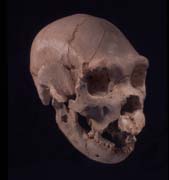 |
| SPANISH HUMANOID SKULL: Now on display at the American Museum. |
These come from two sites in Castile & Leon, the Gran Dolima and Sima de los Huesos-the Pit of Bones. Here have been found the fossil remains an 800,000-year-old species, now called Homo antecessor. Not Man as we know him, but Man's predecessor…
The Natural History Museum-long a leader in such fossil-expeditions, with one of the finest collections in the world-has been working with Spanish anthropologists on excavating the sites. And on reconstructing skeletons, jaw-bones, and artifacts, in an effort to interpret their possible importance in the long march of Evolution.
There are over 90 fossils and artifacts on display, including a skeletal reconstruction which is quite impressive. Even one of the "dig" sites has been partially evoked in this show. This, in effect, pads out what otherwise might have been a much smaller display, but it is visually effective.
Following the recent remarkable display-at the Cathedral of St. John the Divine-of rare medieval religious art-treasures from the great churches of Castile & Leon, it would seem that the authorities of this historic area of Spain are also interested in stimulating tourism. Handsome brochures outlining rewarding sites have certainly accompanied the shows.
Remember the Tet Offensive?
And the Asian War America Did Not Win?
Healing Now at the American Museum of Natural History:
VIETNAM: Journeys of Body, Mind, and Spirit-
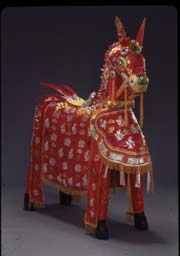 |
| VIETNAM JOURNEYS: Lon Dong Ceremonial Horse for Spirit Mandarin. |
Colorful family altars, intricate objects for funeral rites, and even children's toys for seasonal festivals are all on view. Videos of joyous celebrations do not even hint at the depth of suffering, loss, and destruction the Vietnamese experienced at the hands of American generals and politicians who wanted to halt the Domino Effect of Communism in Asia.
This impressive installation-complete with Vietnamese Cafe & Shop-is only the most visible indication of the new and healing scientific cooperation between the American Museum and the Vietnam Museum of Ethnology.
The 400 objects on display illuminate some of the 54 distinct ethnic groups in Vietnam. Although many of the items look like museum treasures, they are in daily use in Vietnam, made by ingenious native-craftsmen.
The Blockbuster of the New Century?
MATISSE PICASSO at MoMA QNS-
[13 February-19 May 2003] If Glenn Lowry or any of his MoMA curators had any doubts about the museum's ability to attract large crowds to its temporary home in Queens, the Matisse Picasso show has definitively resolved them.In selecting especially resonant canvases from the works of Pablo Picasso and of Henri Matisse, the object was not to suggest that they copied subjects from each other. Of course some of the pairings do evidence some similarities, whether in subject, composition, line, and/or use of color.
The effect of the show is to demonstrate how these two Masters of the Modern actually influenced each other over their long careers. Not as collaborators, nor even as confrontational competitors.
But as two adventurous artists, always exploring, developing, daring-and carefully watching what the other was doing. Critics have rightly suggested that Picasso's bold experiments in fact helped Matisse become the towering Mattise of Modern Art.
One of the least persuasive pairings in the show, however, is the comparison of Picasso's astonishing Les Demoiselles d'Avignon with Matisse's Bathers With a Turtle. Relationships are certainly there, but, in composition and subjects, there is not the affinity that is revealed in other couplings.
Remembering the Holocaust in Brooklyn-
The Last Expression: ART AND AUSCHWITZ:
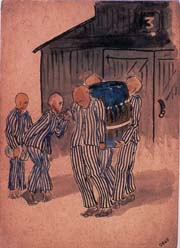 |
| AUSCHWITZ DINNER-TIME: KZ inmates carry food to fellow-prisoners, on view at Brooklyn Museum. |
Over 200 of the drawings made in Auschwitz, Buchenwald, and Drancy-as well as in the Jewish ghetto of Lodz and Gestapo "show-city" of Theresienstadt-are now on view in a powerfully designed & installed show at the Brooklyn Museum.
The detail of the routines-and the horrors-of the camps are graphically rendered. But it's amazing that some of these sketches even have elements of humor about them.
Most amazing is that some of the more painful of these pictures have survived. Especially that they have survived the amateur and the trained artists who created them.
In some cases, however, the inmate artists were "commissioned" or ordered by SS officers to depict aspects of camp life, showing their situation more as labor-relocation than brutal incarceration and torture.
At the Jewish Museum:
ENTERTAINING AMERICA:
Jews, Movies, and Broadcasting-
[21 February -14 September 2003] American Anti-Semites have
long complained that Jewish themes, customs, ideas, and values have been promoted
in the media. To the detriment of WASP values, whatever they may be…
Just as Republican SuperConservatives now charge that the media promote Liberal Agendas-to the detriment of the National Rifle Association, Anti-Abortion Activism, and Faith-Based Christian Initiatives.
The fascinating new show at the Jewish Museum examines some of the tired
old charges. From the evidence on view-photos, documents, books, film-clips,
videos-it is clear that there has been no Secret Conspiracy to Undermine Wasp
Hegemony.
 |
| ENTERTAINING AMERICA: Poster from Jewish Museum show on Jews in broadcasting and films. |
If the historic stuffiness and self-righteousness of the Mayflower Descendants have been satirized on occasion, it is also clear that the qualities and values which made American great have been more often celebrated, even enshrined, by Jewish film-makers and broadcasters.
Neal Gabler's seminal book-An Empire of Their Own: How the Jews Invented Hollywood-is a kind of subtext to this wide-ranging, informative, and, yes, entertaining exhibition.
Gabler persuasively suggested that Jewish producers & studio-chiefs-many of them immigrants from Eastern Europe-actually helped shape the idealized picture of small-town and big-city America that emerged in the movies of the 1920s and 1930s.
Far from promoting "alien values," they sought assimilation, acceptance, and equal rights as American citizens. This is very well demonstrated-both visually and textually-in this show.
In the process, however-with shows such as The Goldbergs and Seinfeld, and very popular stars who celebrated their faith and essential humanity-the American Public came to know much more about Jewish beliefs, customs, humor, and values through watching people to whom they could relate as friends and neighbors.
Entertaining America also emphasizes that Jewish artists, actors, and writers have often been in the vanguard of safeguarding threatened American Rights and improving the social, educational, and economic situation of other American Minorities.
The Red Scare-and the Red Channels Blacklists-are faced squarely and honestly in this show as well.
Briefly at the New-York Historical Society-
Then on to DC's Decatur House and Beyond!
FREEDOM: A History of US
For any who missed the impressive collection of American Documents of Freedom recently on view on Central Park West, there will be six traveling exhibits touring the United States.These are in conjunction with the "Landmark PBS Series" of the same title, hosted by Katie Couric. With historic voices provided by major Hollywood Stars…
Channel 13/WNET and the series-producers premiered the series, opened the exhibition, and launched a handsome book of documents, illustrations, and texts which outline the essence of the TV documentaries at the New-York Historical Society.
Many of the original manuscripts and documents are from the Gilder Lehrman Collection-on deposit at the Morgan Library. Among some of the finer items: a 1776 printing of the Declaration of Independence, Lincoln's Life Mask, and Lincoln's notes for his speeches.
The Freedoms explored in the exhibition, the book, and the TV series are not only those invoked in throwing off the domination of England, but also those won for African-Americans, Women, and other oppressed groups.
Currently-as the Morgan prepares for major architectural innovations-the regular American History Lectures of the Gilder Lehrman Foundation are being given at the NYPL in the Cecile Bartos Forum.
Honoring New York Women on Upper Fifth Avenue:
Photos & Artifacts at Museum of the City of New York-
70Up: New York Women in Their Prime:
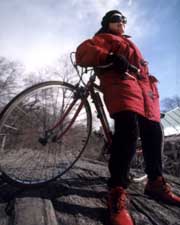 |
| Lorraine Gewirtz,
2002 Photograph by Jessica Chornesky |
Very large color photographs of outstanding 70-years-and-up Manhattan women are now on view in the downstairs galleries. These are the work of the dynamic, if gray-haired, professional photographer Jessica Chornesky.
Among her spirited subjects are LaMaMa's Ellen Stewart [b. 1919], AIDS-researcher Dr. Mathilde Krim [b. 1926], activist Betty Friedan [1921], and actresses Angela Lansbury [b. 1925] and Kitty Carlisle Hart [b. 1915].
But Jessica Chornesky has also included sensitive portraits of unknown, unsung New York grandmothers who also contribute to the fabric of metropolitan life.
This photo-show is offered in partnership with the Burden Center for the Aging, which helps Seniors on the Upper East Side.
Roaring into the Twenties:
The NEW New York Woman-
[22 March-14 September 2003] The Jazz Age is evoked by this
major nostalgia-show of costumes, jewelry, photos, documents, and memorabilia
from the 1920s. Three main areas of Women's Concerns are addressed: Fashion,
Entertainment, and Health & Beauty.
But The Life of the Mind is not-understandably-a Big Item, in recalling New York Women in the Age of the Flapper. Some might consider this as Sexist or Retro, but go see the show and judge for yourself!
The Lincoln Center Library for the Performing Arts has collaborated on the exhibition, drawing on its vast collections. From the world of the arts, such personalities as Dorothy Parker, Sophie Tucker, Louise Brooks, Anne Nichols, Ann Pennington, and Anita Loos are represented.
Elizabeth Arden and Helena Rubinstein also receive their due for their services to New York Women.
From the world of fashion, frocks by Lanvin, Chanel, and Poiret are a vivid testimony to the more superficial concerns of New York Women in the 1920s.
Does all this sound rather frivolous?
Compared with the later contributions to New York Life by women like Dr. Krim, Ms. Friedan, and Ellen Stewart, it seems more like a glittering footnote to Manhattan History, on the cusp of the Depression and the abyss of World War II.
Robots on Parade at the Whitney!
SCANNING:
The Aberrant Architectures of Diller + Scofidio
 |
| Computer rendering of Institute of Contemporary Art, Boston, harbor view, 2002 |
As they jerk forward and then lurch to a halt, tiny TV cameras record their progressions, which are then shown on a bank of monitors on one wall.
They descend below the surface at times, only to rise out of the depths again on seamless inclined trackage.
The husband & wife team of Elizabeth Diller and Ricardo Scofidio also design unusual buildings, video-pieces, art-installations, and even dress-shirts folded into origami-epics.
This retrospective is anything but Retro! It explores the duo's major issues: Display, Tourism, Surveillance, Ritual, & Control.
Frank Ghery, eat your heart out!
New Dahesh Home on Madison:
Hardy Holzman Pfeiffer Design Interior-
Formerly confined to a small second-story chamber on Fifth Avenue, the Dahesh
Museum-with its impressive collection of 19th century salon art-plans to open
its new galleries Summer 2003.
To achieve this, contractors will have to work very fast, as the three-story space in the IBM Building on Madison Avenue has had other show-oriented tenants with different requirements. The IBM Gallery-which regularly offered outstanding shows midtown-was the first. Followed by the Freedom Forum…
With the entire basement gallery-space, the ground-floor entry, and a smaller second-floor gallery, the Dahesh will have far more space than on Fifth. Now major exhibitions can be mounted, rather than selections of small artworks.
The Dahesh had campaigned to acquire the former Huntington Hartford Gallery on Columbus Circle, designed by Edward Durrell Stone. Others with more clout won out.
Hartford's dreams of being a Major Culture Patron in Manhattan did not work out. Just as his dreams of film-making, performing arts publications, and other adventures failed. Only Paradise Island survived, but not under his aegis.
So the Columbus Circle building ultimately passed to the City. But the City of New York was never able to use this slim structure effectively as a Tourist & Culture Center.
Losing out will prove, in fact, the Dahesh's good luck, for the layout of the uptown gallery-thanks to the small & odd-shaped plot on which it stands-was really quite awkward for both hanging paintings and circulating spectators.
The IBM midtown location has been proven an ideal site for exhibitions.
Retro at SFMOMA:
Diane Arbus: Revelations-
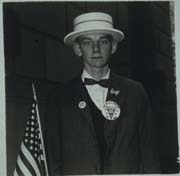 |
| DIANE ARBUS CLASSIC PHOTO: Boy with straw hat waiting to march in a pro-war parade. |
On view will be more than 200 of Arbus's often troubling images. Some of these have not been shown previously.
Contact-sheets, cameras, notes, letters, and other Arbus Documentation will also be shown, to help explain her modus operandi and her very special vision.
You don't have to fly off to SF to see the show, however. If you can stand to wait until February 2005, it will come to the Met Museum.
At the International Center of Photography:
Weegee's Trick Photos &
Fox Talbot & The Birth of Photography
[13 December-16 February 2003] By the time you read this,
both these fascinating shows will be on their way to other venues. But you can
recapture the effect of both from published photos and explanatory texts.  |
| Weegee Marilyn Monroe, ca. 1952 |
Weegee's unusual distorting lenses-shooting through glass ashtrays, for instance-enabled
him to create some memorable grotesques. His love of camera-collaging exposures
also resulted in bizarre images.
 |
| William Henry
Fox Talbot and possibly Antoine Claudet Nicolaas Henneman Asleep at Lacock or Reading, England, 1844/45 |
Fox Talbot, of course, is the grand-daddy of them all. A wealthy gentleman, a gentleman scientist, and an inquiring intellectual, Fox Talbot had the leisure, the money, and the curiosity to lay the foundations of modern photography.
OUTSIDER ART FAIR 2003-
One of the most unusual and colorful of Manhattan Art Shows is the annual Outsider Art Fair at the Puck Building. Owing to the nook & cranny effect of the oddly interlinked exhibit-spaces, this is not ideal for a conventional show.But it offers wonderful little alcoves and cul de sacs for the display of some of the most unusual drawings, paintings, pastings, bastings, sculptures, and constructions you can hope to find anywhere today.
Staged by Sanford L. Smith & Assocs., this year's was the eleventh show. And it has grown to international scale, with 32 dealers from six countries.
Of course, Manhattan dealers-like Galerie St. Etienne-also have a wide range of naive art and Art Brut from at home and abroad. This fine gallery features the wild American adventures of Henry Darger's prepubescent girls, as well as the asylum-bred Austrian images of Josef Karl Rädler and the New England scenes of Grandma Moses.
Way Beyond the Merely Naive-
WORKS ON PAPER at the Park Ave Armory
This was the 15th anniversary of the always challenging Works on Paper, also produced by Sanford L. Smith & Associates. Challenging, because each year sees something entirely new: a new theme, a new style, a new technique, a new surface-some of which may be more bark than paper.The supply of Toulouse-Lautrec posters of Aristide Bruant or of Jane Avril seems bottomless. Jugendstil posters from Vienna, Munich, Berlin, Mannheim, or Düsseldorf are rather more rare. And rather different in their varied styles, although Jugend is linked to Art Nouveau.
But I looked in vain for a poster from Mathildenhöhe and the Darmstädter Künstler Kolonie, especially one designed by Peter Behrens. Probably such posters are now beyond the means of any but the wealthiest of collectors.
It's interesting to realize that a Rembrandt etching is just as much a Work on Paper as a Coca-Cola poster. And the Sanford Smith annual always provides many really rare and valuable collector-prints, as well as the most modish innovations.
Among the handsome catalogues I collected was Modern Master Prints of Sims Reed Gallery in London. Its full-color, full-page illustrations-plus small vignettes-make it a collector's item itself!
The print-catalogues of the Childs Gallery and the William Weston Gallery, both British, were handsome objects I now have on my desk for visual refreshment.
Among impressive talents previously unknown to me, I especially admired Leo McDowell, with bold patches of color and nervous lines. He is represented by the Adam Gallery. [Loney]
Copyright © Glenn Loney 2003. No re-publication or broadcast use without proper credit of authorship. Suggested credit line: "Glenn Loney, Curator's Choice." Reproduction rights please contact: jslaff@nymuseums.com.